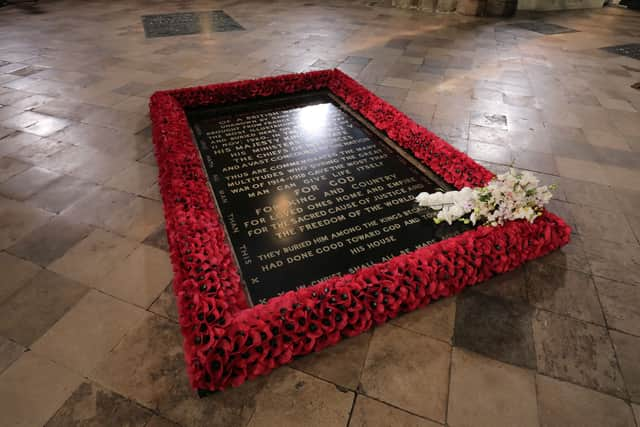The Tomb of the Unknown Soldier: where is it, what is the origin and who is buried there?
and live on Freeview channel 276
The Tomb of the Unknown Soldier is one of the most poignant symbols of Remembrance Day.
Armistice Day takes place on 11 November each year, to mark the day the guns fell silent during the First World War. Remembrance Sunday takes place on the closest Sunday to that date.
Advertisement
Hide AdAdvertisement
Hide AdA service will take place at The Cenotaph led by the King, with Charles III taking the leading role for the first time since he ascended to the throne. The Festival of Remembrance will take place on Saturday (12 November) night.
One of the most recognisable symbols of remembrance in the UK is the Tomb of the Unknown Soldier. It will play a key part in the ceremonial events over the weekend.
But have you ever wondered where the grave is? Or wondered who is inside the tomb and what is the origin? Here is all you need to know:
Where is the Tomb of the Unknown Soldier?
Also known as the Unknown Warrior, the grave is located in Westminster Abbey. It contains the remains of a member of the armed forces killed in the First World War and he was buried in the grave on Armistice Day in 1920.
Advertisement
Hide AdAdvertisement
Hide AdIt is located inside the west entrance of Westminster Abbey. You can find the hallowed grave in the Chapel of the Holy.


Who is inside the Tomb of the Unknown Soldier?
The remains of a member of the British armed forces killed during the First World War is inside the grave. The indentity of the soldier is unknown.
Sutiable candidates were exhumed from various battlefields in Europe from during the war. The chosen body was taken to Westminster and buried on 11 November 1920.
The identity of the soldier is unknown like many fallen heroes in both World Wars. The grave serves as a memorial for all the unknown dead killed in wars for Britain.
Advertisement
Hide AdAdvertisement
Hide AdWhat is the origin of the Tomb of the Unknown Soldier?
The idea for the Tomb of the Unknown Solider traces back to 1916, as the fighting during the First World War raged on. It is credited with being conceived by Reverend David Railton who was serving as a chaplain on the Western Front.
He came across a grave marked by a rough cross which bore the legend ‘an unknown British soldier’ in pencil. However it was not until the 1920s until the Tomb of the Unknown Soldier materialised.
Reverend Railton wrote to the dean of Westminster Abbey Herbet Ryle in 1920 proposing the idea of the grave. He suggest exhuming an unidentified soldier from the battlefields in France and to buried “among kings” in the London church to represent the many troops who had died during the war.
How was the soldier chosen for the Tomb?
Lord Curzon of Kedleston handled the arrangements after the plans were approved by prime minister David Lloyd George. He arranged for suitable remains to be exhumed from various battlefields and they were brought to the chapel at Saint-Pol-sur-Ternoise near Arras, France on the night of 8 November 1920.
Advertisement
Hide AdAdvertisement
Hide AdThe bodies were received by Reverend George Kendall OBE and placed into four coffins, each of which were covered by a Union flag. Brigadier L.J. Wyatt is said to have closed his eyes and put his hand on a coffin and the chosen one was taken to be buried at Westminster Abbey.
The three remaining coffins were taken away and reburied. France also interned an unknown soldier at the Arc de Triomphe in Paris on 11 November 1920, the same day as the unknown solider was laid to rest at Westminster Abbey.
Comment Guidelines
National World encourages reader discussion on our stories. User feedback, insights and back-and-forth exchanges add a rich layer of context to reporting. Please review our Community Guidelines before commenting.